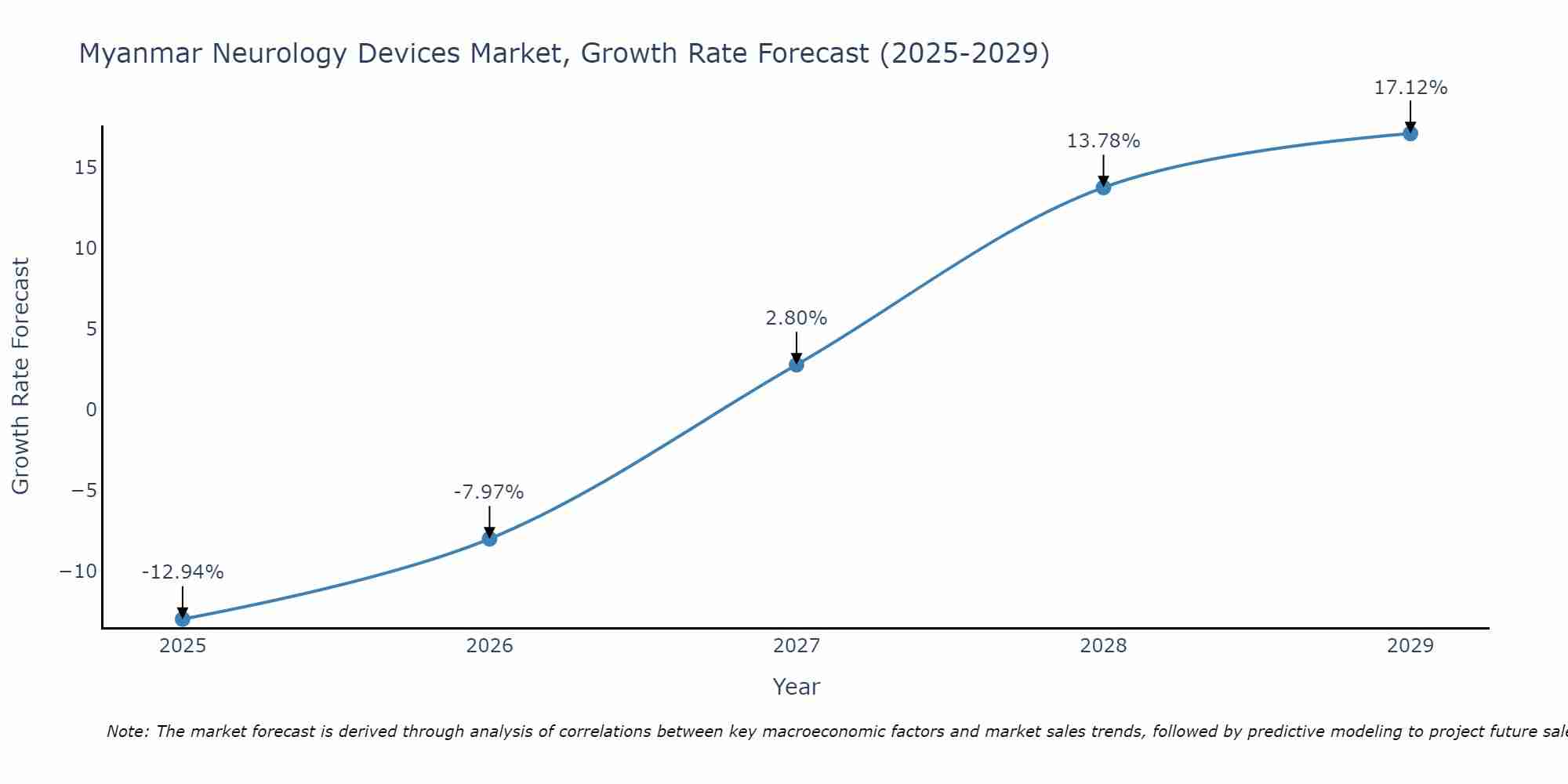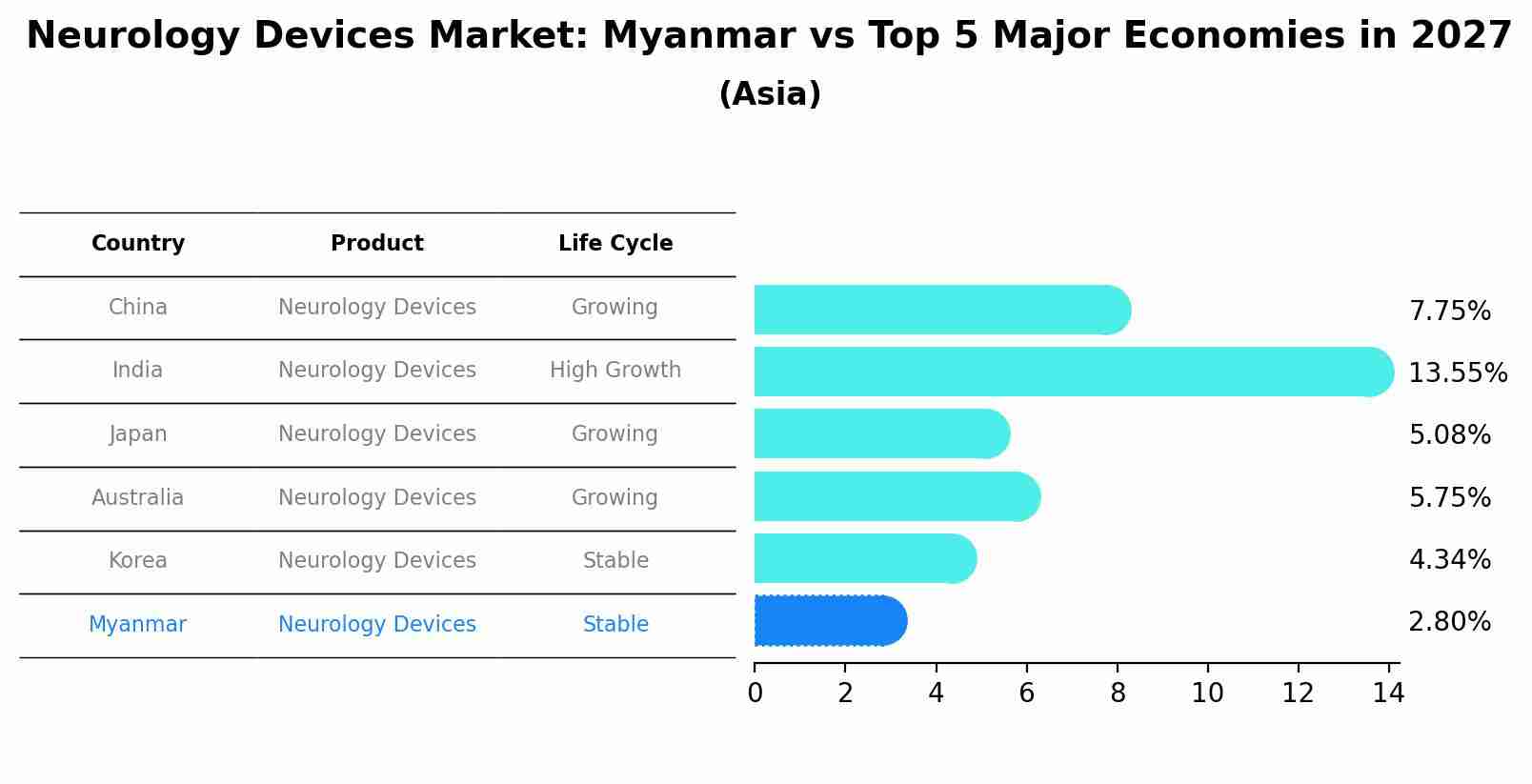Myanmar Neurology Devices Market Outlook | Share, COVID-19 IMPACT, Analysis, Revenue, Trends, Size, Industry, Growth, Value, Companies & Forecast
| Product Code: ETC367654 | Publication Date: Aug 2022 | Updated Date: Apr 2025 | Product Type: Market Research Report | |
| Publisher: 6Wresearch | Author: Shubham Padhi | No. of Pages: 75 | No. of Figures: 35 | No. of Tables: 20 |
Myanmar Neurology Devices Market Size Growth Rate
The Myanmar Neurology Devices Market is likely to experience consistent growth rate gains over the period 2025 to 2029. Commencing at -12.94% in 2025, growth builds up to 17.12% by 2029.

Neurology Devices Market: Myanmar vs Top 5 Major Economies in 2027 (Asia)
By 2027, the Neurology Devices market in Myanmar is anticipated to reach a growth rate of 2.80%, as part of an increasingly competitive Asia region, where China remains at the forefront, supported by India, Japan, Australia and South Korea, driving innovations and market adoption across sectors.

Myanmar Neurology Devices Market Overview
The Neurology Devices market in Myanmar is witnessing growth as healthcare providers invest in medical devices to diagnose and treat neurological disorders. Neurology devices include diagnostic equipment, therapeutic devices, and monitoring tools used in neurology clinics and hospitals. The market growth is driven by the rising prevalence of neurological conditions and the increasing demand for advanced healthcare services.
Drivers of the market
The Myanmar neurology devices market is experiencing steady growth due to the rising prevalence of neurological disorders and the increasing focus on healthcare infrastructure development in the country. Neurology devices, including electroencephalography (EEG) machines, magnetic resonance imaging (MRI) systems, and neurostimulation devices, play a crucial role in the diagnosis, treatment, and management of neurological conditions. With the growing elderly population and the rising awareness about neurological health, there is a growing demand for advanced neurology devices. Additionally, government initiatives to improve access to healthcare services and investments in medical technology are supporting market growth.
Challenges of the market
The Myanmar neurology devices market faces challenges related to limited access to advanced medical technology and expertise. Providing neurology devices and services requires investments in equipment, training, and infrastructure to support diagnosis and treatment. Moreover, ensuring regulatory compliance and addressing concerns about affordability and accessibility pose additional hurdles for companies operating in this sector.
Government Policy of the market
Myanmar prioritizes the availability and accessibility of neurology devices to support healthcare and medical research. Regulations ensure device safety and effectiveness, promote local production, and encourage research and development to address neurological health needs.
Key Highlights of the Report:
- Myanmar Neurology Devices Market Outlook
- Market Size of Myanmar Neurology Devices Market, 2024
- Forecast of Myanmar Neurology Devices Market, 2031
- Historical Data and Forecast of Myanmar Neurology Devices Revenues & Volume for the Period 2018 - 2031
- Myanmar Neurology Devices Market Trend Evolution
- Myanmar Neurology Devices Market Drivers and Challenges
- Myanmar Neurology Devices Price Trends
- Myanmar Neurology Devices Porter's Five Forces
- Myanmar Neurology Devices Industry Life Cycle
- Historical Data and Forecast of Myanmar Neurology Devices Market Revenues & Volume By Product for the Period 2018 - 2031
- Historical Data and Forecast of Myanmar Neurology Devices Market Revenues & Volume By Neurostimulation Devices for the Period 2018 - 2031
- Historical Data and Forecast of Myanmar Neurology Devices Market Revenues & Volume By Neurosurgery Devices for the Period 2018 - 2031
- Historical Data and Forecast of Myanmar Neurology Devices Market Revenues & Volume By Interventional Neurology Devices for the Period 2018 - 2031
- Historical Data and Forecast of Myanmar Neurology Devices Market Revenues & Volume By Cerebrospinal fluid management devices for the Period 2018 - 2031
- Historical Data and Forecast of Myanmar Neurology Devices Market Revenues & Volume By Others for the Period 2018 - 2031
- Historical Data and Forecast of Myanmar Neurology Devices Market Revenues & Volume By End User for the Period 2018 - 2031
- Historical Data and Forecast of Myanmar Neurology Devices Market Revenues & Volume By Hospitals for the Period 2018 - 2031
- Historical Data and Forecast of Myanmar Neurology Devices Market Revenues & Volume By Ambulatory surgery centers for the Period 2018 - 2031
- Historical Data and Forecast of Myanmar Neurology Devices Market Revenues & Volume By Neurology clinics for the Period 2018 - 2031
- Myanmar Neurology Devices Import Export Trade Statistics
- Market Opportunity Assessment By Product
- Market Opportunity Assessment By End User
- Myanmar Neurology Devices Top Companies Market Share
- Myanmar Neurology Devices Competitive Benchmarking By Technical and Operational Parameters
- Myanmar Neurology Devices Company Profiles
- Myanmar Neurology Devices Key Strategic Recommendations
Frequently Asked Questions About the Market Study (FAQs):
- Single User License$ 1,995
- Department License$ 2,400
- Site License$ 3,120
- Global License$ 3,795
Search
Related Reports
- Saudi Arabia Manlift Market (2025-2031) | Outlook, Size, Growth, Trends, Companies, Industry, Revenue, Value, Share, Forecast & Analysis
- Uganda Excavator, Crane, and Wheel Loaders Market (2025-2031) | Strategy, Consumer Insights, Analysis, Investment Trends, Opportunities, Growth, Size, Share, Industry, Revenue, Segments, Value, Segmentation, Supply, Forecast, Restraints, Outlook, Competition, Drivers, Trends, Demand, Pricing Analysis, Competitive, Strategic Insights, Companies, Challenges
- Rwanda Excavator, Crane, and Wheel Loaders Market (2025-2031) | Strategy, Consumer Insights, Analysis, Investment Trends, Opportunities, Growth, Size, Share, Industry, Revenue, Segments, Value, Segmentation, Supply, Forecast, Restraints, Outlook, Competition, Drivers, Trends, Demand, Pricing Analysis, Competitive, Strategic Insights, Companies, Challenges
- Kenya Excavator, Crane, and Wheel Loaders Market (2025-2031) | Strategy, Consumer Insights, Analysis, Investment Trends, Opportunities, Growth, Size, Share, Industry, Revenue, Segments, Value, Segmentation, Supply, Forecast, Restraints, Outlook, Competition, Drivers, Trends, Demand, Pricing Analysis, Competitive, Strategic Insights, Companies, Challenges
- Angola Excavator, Crane, and Wheel Loaders Market (2025-2031) | Strategy, Consumer Insights, Analysis, Investment Trends, Opportunities, Growth, Size, Share, Industry, Revenue, Segments, Value, Segmentation, Supply, Forecast, Restraints, Outlook, Competition, Drivers, Trends, Demand, Pricing Analysis, Competitive, Strategic Insights, Companies, Challenges
- Israel Intelligent Transport System Market (2025-2031) | Strategy, Consumer Insights, Analysis, Investment Trends, Opportunities, Growth, Size, Share, Industry, Revenue, Segments, Value, Segmentation, Supply, Forecast, Restraints, Outlook, Competition, Drivers, Trends, Demand, Pricing Analysis, Competitive, Strategic Insights, Companies, Challenges
- Uganda Precast and Aggregate Market (2025-2031) | Strategy, Consumer Insights, Analysis, Investment Trends, Opportunities, Growth, Size, Share, Industry, Revenue, Segments, Value, Segmentation, Supply, Forecast, Restraints, Outlook, Competition, Drivers, Trends, Demand, Pricing Analysis, Competitive, Strategic Insights, Companies, Challenges
- Australia IT Asset Disposal Market (2025-2031) | Strategy, Consumer Insights, Analysis, Investment Trends, Opportunities, Growth, Size, Share, Industry, Revenue, Segments, Value, Segmentation, Supply, Forecast, Restraints, Outlook, Competition, Drivers, Trends, Demand, Pricing Analysis, Competitive, Strategic Insights, Companies, Challenges
- UAE Building Thermal Insulation Market Outlook (2025-2031) | Revenue, Companies, Share, Trends, Growth, Size, Forecast, Industry, Analysis & Value
- Portugal Electronic Document Management Market (2025-2031) | Strategy, Consumer Insights, Analysis, Investment Trends, Opportunities, Growth, Size, Share, Industry, Revenue, Segments, Value, Segmentation, Supply, Forecast, Restraints, Outlook, Competition, Drivers, Trends, Demand, Pricing Analysis, Competitive, Strategic Insights, Companies, Challenges
Industry Events and Analyst Meet
Our Clients
Whitepaper
- Middle East & Africa Commercial Security Market Click here to view more.
- Middle East & Africa Fire Safety Systems & Equipment Market Click here to view more.
- GCC Drone Market Click here to view more.
- Middle East Lighting Fixture Market Click here to view more.
- GCC Physical & Perimeter Security Market Click here to view more.
6WResearch In News
- Doha a strategic location for EV manufacturing hub: IPA Qatar
- Demand for luxury TVs surging in the GCC, says Samsung
- Empowering Growth: The Thriving Journey of Bangladesh’s Cable Industry
- Demand for luxury TVs surging in the GCC, says Samsung
- Video call with a traditional healer? Once unthinkable, it’s now common in South Africa
- Intelligent Buildings To Smooth GCC’s Path To Net Zero













